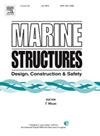Springing responses of ships with forward speed based on a multi-module hydroelastic method
IF 4
2区 工程技术
Q1 ENGINEERING, CIVIL
引用次数: 0
Abstract
A hydroelastic analysis method for flexible ships with forward speed is developed based on the beam-connected-discrete-modules (BCDM) approach. In this method, the flexible ship is first discretized into multiple rigid modules connected by a hull girder, thereby establishing the hydroelastic analysis model. The time-domain Rankine source method, which incorporates steady flow through the double body flow model, is employed to calculate the hydrodynamic forces acting on the multi-module system. The subsequent application of Fourier transformation facilitates the conversion of these forces into the frequency domain, where they are coupled with the structural stiffness of the hull girder to formulate the hydroelastic equations for advancing ships. Additionally, the time-domain hydroelastic equation is derived based on Cummins’ equation. The validity of the proposed method is conducted by comparing the zero-speed hydroelastic responses and the motions of advancing ships with the published data and numerical results from commercial software. Furthermore, the global responses of both flexible and rigid ships under varying forward speed conditions are thoroughly investigated. The results demonstrate that the flexible deformation plays a crucial role in the global responses of advancing ships, and hydrodynamic forces associated with forward speed have significant contribution to the hydroelastic responses.
基于多模量水弹性方法的船舶正航速弹跳响应
提出了一种基于梁连接离散模组(BCDM)方法的正航速柔性船舶水弹性分析方法。该方法首先将柔性船舶离散为由船体梁连接的多个刚性模块,从而建立水弹性分析模型。采用时域朗肯源法,通过双体流模型计算定常流,计算作用在多模块系统上的水动力。傅里叶变换的后续应用有助于将这些力转换到频域,在频域中,它们与船体梁的结构刚度耦合,形成前进船舶的水弹性方程。此外,在康明斯方程的基础上推导了时域水弹性方程。通过与已发表的数据和商业软件的数值结果比较零速水弹性响应和前进船舶运动,验证了该方法的有效性。此外,还深入研究了柔性船舶和刚性船舶在不同前进速度条件下的全局响应。研究结果表明:柔性变形对船舶前进的整体响应起着至关重要的作用,而与前进速度相关的水动力对船舶的水弹性响应有重要的贡献。
本文章由计算机程序翻译,如有差异,请以英文原文为准。
求助全文
约1分钟内获得全文
求助全文
来源期刊

Marine Structures
工程技术-工程:海洋
CiteScore
8.70
自引率
7.70%
发文量
157
审稿时长
6.4 months
期刊介绍:
This journal aims to provide a medium for presentation and discussion of the latest developments in research, design, fabrication and in-service experience relating to marine structures, i.e., all structures of steel, concrete, light alloy or composite construction having an interface with the sea, including ships, fixed and mobile offshore platforms, submarine and submersibles, pipelines, subsea systems for shallow and deep ocean operations and coastal structures such as piers.
 求助内容:
求助内容: 应助结果提醒方式:
应助结果提醒方式:


